|
Yum, Yum Donuts...
Brian Boyer, Cinnabar Hills Golf Club, San Jose, CA:
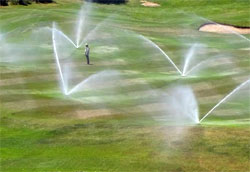  "Lately we have been witnessing a lot of donuts in our fairways. Donuts refer to the green circles around the sprinklers with a brown ring approximately 15 ft outside of that. We are doing some experimenting with different nozzle sizes and types now before we purchase 1,500 nozzles for the fairways.
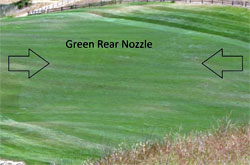 We believe we have found two solutions, but we are going to evaluate a bit more before we decide to buy. One solution is to use a different rear nozzle configuration from Rain Bird. This particular nozzle configuration doesn't diffuse the water as much and keeps the area around the head more evenly distributed (see picture above right).
The other solution is to remove the small opaque colored diffuser in our current nozzle configuration. At the moment there seems to be some improvement by doing this. If this works, we could save ourselves almost $4,000 in new nozzles."
Visit Brian's blog at cinnabarhills.blogspot.com
|
 |
|
Irrigation time...
David Brandenburg, CGCS, Rolling Meadows Golf Course, Fond du Lac, WI:
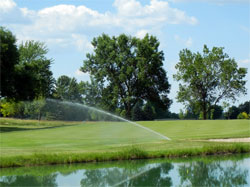  (Excerpt) "How do we decide when and how much to water? We use information from our weather station and a e-mail service from UW-Madison to determine our Evapotranspiration Rate (ET Rate). The ET is a combination of how much water a the grass plants would use in a day plus the amount of water evaporated into the atmosphere. The ET rate is calculated by temperature, sunshine, wind, humidity and dew point. Believe it or not the rate is usually higher in June than it is the hot dog days of August because the humidity is lower in June.
"Believe it or not the (ET) rate is usually higher in June than it is the hot dog days of August because the humidity is lower in June...." |
So far in the month of June our ET has averaged an amazing .23", or almost a quarter inch a day of water use or evaporation with peak days of .34". University research has shown that plants are healthiest if we replace 80% of the ET. .23' x 80% equals .18" of water a day we need to apply for healthy turf. Under normal circumstances we try to water ever second or third day so we try to apply .36" or .54' of water per application.
No matter how new or technologically advanced an irrigation system is they do not replace rain, and in Wisconsin they are designed only to supplement rain. Long-term dry periods lead to wet spots from too much water and dry spots from too little water. We do our best to find these areas and increase or decrease coverage but our biggest problem is right around the heads or right in the center of the fairway where extra water is spilled when the heads turn on and off and with the single row spacing the area is hit by three heads.
Perfect green is not our goal with irrigation. Our goal is healthy but playable turf, and dry and a little brown is better than wet and bright green."
Visit David's blog at rmgc-maint.blogspot.com
|
 |
|
Taking the Bite Out of the Bark...
Joel Kachmarek, Tacoma Country and Golf Club, Lakewood, WA:
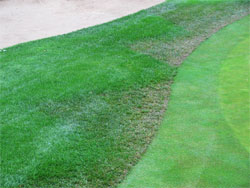  (Excerpt, after waxing poetic about the benefits of Embark on his pure Poa greens)
"The photo to the right shows overspray of Embark® into the surrounds of the putting surface, taken after three consecutive applications of Embark spaced out at 14 day intervals. After the first application, the negative bronzing effect is no longer an issue but after multiple applications, the roughs can no longer tolerate it. I took this photo last year and made a commitment to come up with a solution so that this year we can keep the greens 'barked'. I needed to find a way to take the bite out of the bark.
It's pretty easy to see why I want to keep (the greens) barked. They look great, they putt amazing, and we save so much labor by not having to mow them. Fairway turf regulated by embark is even more amazing considering labor savings. Mowing fairways once a week is more than adequate when they are barked. Also, the turf just seems healthier most of the time. We never see fusarium while under the influence of embark because there is no juvenile growing tissue to be infected. In fact, ever since I started spraying embark back in 2009, we have had no real disease issues period."
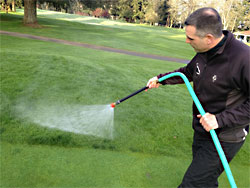 So here is my solution to the bark bite. I wash the spray off the turf in the roughs. The picture to the right was taken just seconds after the green was sprayed. It's best to get the spray off the roughs as soon as possible. This technique has worked very well. So well in fact that I'm thinking of doing this with all applications made to the putting greens.
By eliminating the response from spray to the surrounding roughs, my surround turf looks better than ever, and more natural. Here is a picture of the first green I took yesterday. Currently we are 12 days out following the fourth consecutive application of Embark. Our greens have been 12 or more on the stimpmeter every day since we started our first application back in April. As you can see, the surrounds look great. Now I'm wondering when to get off the bark... if ever." (and there's more...)
Visit Joel's blog at www.tacomaturf.com.
|
 |
|
Hot, hot, hot...
Jason VanBuskirk, Stow Acres Country Club, Stow, MA:
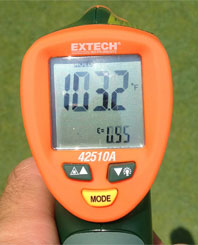  "Over the next few weeks as the temperatures become consistently warm, you will notice staff members syringing the greens with hoses. Yes, we do have sprinklers and yes, we do water at night. This practice allows us to carefully monitor the moisture level and surface temperature level. We are not actually watering the greens, but simply cooling the surface atmosphere right above the plant. Although labor intensive, syringing like this ensures firmer, faster greens and less disease pressure.
The staff do not spend any longer than two minutes on a green surface. If you happen to be waiting to hit your approach, please wait just a minute longer to avoid hitting into them. They are paying attention to you, but they are diligently working to keep the green surfaces alive and playing well."
Visit Jason's blog at stowacresturf.com.
|
 |
|
Getting it done, MacGyver style...
Bob Pruneau, equipment tech, Ashburn Golf Club, Halifax, Nova Scotia:
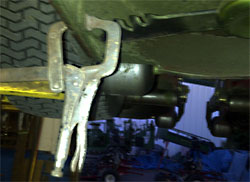  (Excerpt) "I was always looking for a third arm (to keep the blades stationary) when putting fresh blades on the rotaries in the morning. I spotted this clamp hanging on the wall, so gave it a try and it worked great. Sometimes it's looking around at what you have to make things work.
Visit Bob's blog at golfcoursemechanics.blogspot.com.
|
 |
|
Beware in Colorado
Sean McCue, Country Club at Castle Pines, Castle Rock, CO:
 "On the heels of my previous post about treating Poa annua comes a turn of events. If you are brave enough to apply Xonerate™, be sure to read the product label not once, not twice or even a third time of which might not be enough to truly understand the product being applied. I have found it's what is not on the label that can give the best advice on how to use a product properly. Unfortunately this knowledge comes with a price.
It seems as this information is only available after the fact of injury occurring to the desired plant species, which in our case was bentgrass. This information was given to me more 30 days after the product was registered for use in Colorado. The application protocol had apparently changed, far too late for me or anyone who had applied the product per label instructions.
"The application protocol had apparently changed, far too late for me or anyone who had applied the product per label instructions..." |
In my opinion, Arysta LifeScience (the producers of Xonerate herbicide) was only concerned with getting the product to market without thoroughly testing it in all markets before release. The latest and greatest Poa control product can yield a fortune in revenue coming back into the company that can expedite the return on investment. This was clearly the case in Colorado.
In the last week I have received several phone calls from fellow superintendents in Colorado who are experiencing the same (if not worse) injury to bentgrass. To make matters worse, the product Xonerate had little or no control on the Poa annua which it supposedly works so well on. Most of my Poa that was treated couldn't look healthier, while the amount of damage that occurred to the bentgrass makes this product unusable for me going forward. This is the exact opposite of how this product has been marketed.
"The combination of low humidity and significantly higher intensity of sun rays appear to affect how the product is absorbed..." |
I believe a big factor in using this product in Colorado was overlooked and or underestimated. Xonerate works by inhibiting photosynthesis within the plant (specifically Poa Annua) and is absorbed through both the leaf and through the root system. The combination of low humidity and significantly higher intensity of sun rays appear to affect how the product is absorbed by the non-target species (bentgrass). More research and testing needs to be done on this matter.
We as golf course superintendents are always looking for products to improve the overall health and playability of the golf course, and it's times like this that some of these latest and greatest products make matters worse. If there are changes to application protocols, manufacturers need to tell someone in a proactive manner. Don't keep this information internally. Let the sales reps know so they can effectively communicate to the end user.
So if you're a golf course superintendent in Colorado considering using Xonerate, I would think long and hard before taking that first step because you will get burned. Just ask me."
Visit Sean's blog at cccpgcm.blogspot.com.
|
 |
|
Dorsal Fins, Voracious Eaters and Helping the Environment
John Slade, Laurel Creek Country Club, Mount Laurel, NJ:
 "At this time of year it's not uncommon to see all kinds of wildlife on the golf course. The lake at #5 green has one of the more interesting inhabitants, grass-eating carp. These herbivorous fish help to control the aquatic weed growth by spending their summer days happily consuming pounds and pounds of filamentous algae, and pondweed. This helps to reduce the need to use chemical controls for the weed growth, thereby allowing us to manage the property in a more environmentally friendly manner.
The lake also has plenty of catfish and bass, but the carp stand out due to their size, and how close they swim to the surface. The carp can grow to four feet in length and weigh up to 40 pounds. You can often see their dorsal fins and tails breaking the surface of the water.
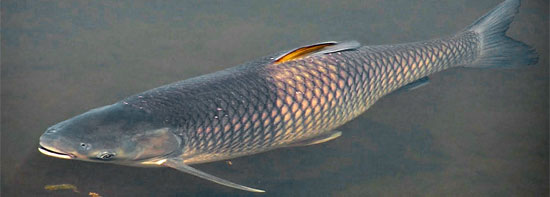
While the carp are definitely wildlife, they are not native to these waters, and were originally brought to the United States from China. Because of their voracious appetites, there would be concern if these fish were released into the wild and allowed to reproduce. By consuming so much vegetation, they could significantly change the ecosystem, potentially harming native fish and other aquatic animals. To prevent this, the carp are sterile, and screening is installed on the lake's discharge piping to keep them from leaving the lake.
So if you see a fin sticking out of the water, have no fear that fresh water sharks have invaded our ponds--it's only the carp, doing what it loves, helping to keep the course and environment in great shape."
Visit John's blog at laurelcreeksuper.blogspot.com.
|
 |
 |
|
About our Blog Aggregator: Many superintendents are now hosting private blogs to better communicate with their golfers and/or members. Beyond local weather and course conditions, there is a great deal of information about projects, methodologies and techniques that would be of value to other superintendents — hence our Turf Blog Aggregator. As every blogger struggles occasionally with content, we also include posts intended to educate golfers about turf maintenance for others to use as a template for their own blogs.
Miss any previous issues of TBA? You can find them all here.
Turf Blog Aggregator(TM) is a trademark of Turnstile Media Group.
|
|